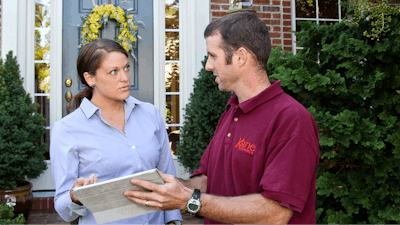
Who are your customers? How did they find you? And what inspired them to choose your landscaping service and not your competitor? Recently, Silverback Strategies launched a survey to answer these questions, with the goal of helping service providers across the country choose the best marketing strategies to reach future customers. Part of a broader study on consumer services, we conducted a special analysis on buyers of residential home services. We focused in on 724 buyers who purchased home services during the summer of 2020 and broke down results by industry.
As a business owner, you likely have a sense of your ideal customer. But to reach them, you need to know what their buying journey looks like, from start to finish — from their first Google search to their final Yelp review. Understanding the behaviors and trends that shape how buyers make decisions can influence your marketing strategy, and help your business stand out in a competitive market. Let’s dig in.
The Buyer’s Journey
Buyers don’t just make sudden a decision to purchase – they go through a process. We boiled it down to five steps: realization, education, evaluation, decision and advocacy.
Step 1: Realization
From buying a new home to wanting to spend more time outside, the decision-making process starts with a buyer realizing they need your service. And after that ‘light bulb moment,’ our research indicates that the internet is the first place they go.
According to survey results, 44% of landscaping buyers went online after they realized they had a problem to solve. Going online was considerably more common than asking a friend or family member for a referral (26%) or calling a previous provider (27%). When we looked at buyers of residential home services across generations, we found notable differences in behavior. For example, 39% of Boomers will call a past contractor for help, as compared to only 15% of Millennials. But despite minor differences across demographic lines, one thing is clear: going online was the go-to strategy for most shoppers in 2020.
For landscaping contractors, this means that investing in your digital brand is a vital part of your marketing strategy, particularly if you want to target younger buyers. A good place to start would be to make sure your website guides users to contact your business and structure your site in a way that makes it easy for Google to display it in search results. This step alone will make it far more likely that a future customer will find you.
Step 2: Education ©Ozgur Coskun - stock.adobe.com
©Ozgur Coskun - stock.adobe.com
After realizing an initial need, buyers then engage in more extensive research and education to decide who the top providers are in their area. Usually, this begins with a search engine – about 26% of buyers start with Google, Bing, or a similar platform. But even though most buyers start their research online, word-of-mouth referrals and personal experience are still popular strategies – about 20% of home service shoppers will start their search by asking a friend or talking to someone they’ve worked with before.
Comparatively, only about 10% of buyers went on social media to do research. But despite this lower ranking during the education phase, social media plays an important foundational role, spreading brand awareness to keep your business top-of-mind, and helping clients better evaluate your services.
In the landscaping industry, Facebook is the most popular social media platform for buyers. More than 70% reported using the site actively, at least once a week. Instagram and YouTube are second and third on that list, with 47% and 46% of buyers saying they actively use those platforms. Investing promoted ads on these platforms can be a great way to improve brand recognition throughout the customer journey.
Step 3: Evaluation
Before making a final decision, buyers evaluate a few top choices they discovered during the education phase. This evaluation typically includes calling contractors and looking at customer reviews and ratings.
The biggest influencers for most customers, beyond cost, is past performance – 43% of customers said this was the primary criteria they used to evaluate a contractor. Ratings and reviews are also important, with 41% of respondents turning to this method. Based on this data, landscapers looking to stand out should having an engaging photo or video gallery of past work, a testimonials page, and solid reviews and ratings across platforms.
Step 4: Decision ©ShadowCast Studios 2019 - stock.adobe.com
©ShadowCast Studios 2019 - stock.adobe.com
Unlike other home service industries, where prospective customers may only call one provider, the landscaping industry is different. Nearly 40% of buyers reported calling two providers, and 35% called three or more. For this reason, landscapers need to be ready to talk about how they are different from their competitors. This starts by understanding your specific customer base and what they value in working with you. Timeliness, responsiveness, quality of work, specialization, past performance — these are all attributes of your business that you can highlight to show what makes your business different from the ‘other guys.’ These messages should appear in your digital marketing, then reinforced in the field.
Step 5: Advocacy
After extensive research and evaluation, buyers finally make that critical decision: they hire your company. But what they do after they’ve chosen your service is almost as important. Ideally, you want your customers to become promoters for your brand. And incentivizing them to advocate for you – via reviews, ratings, and referrals – can help you stand out to future customers.
In the landscaping industry, more than 48% of buyers report leaving reviews for past providers. Landscapers can encourage customers to rate them by sending follow-up emails or text messages after completing a service, or by asking customers directly to leave reviews on specific platforms. The most popular review platforms for home service providers were Facebook and Google – 51% of users said they left reviews on these platforms.
Finally, don’t forget about word of mouth. Incentive programs for customers to refer their friends are still effective, even in the digital age – remember, 20% of people in the education phase ask their network for referrals. Offering a discount on future service or sending out small gift cards when a referral comes in can be great ways to get your past clients talking to their friends about your company.
Meet Your Buyer at Every Stage
In today’s digital world, it’s not enough to provide a top-quality service. Landscapers who want to attract new customers also need a robust digital presence. But that can be a challenge. Effective digital marketing is an orchestration across creative, promotion, and data analytics resources. Companies who can get this right are poised for growth and will attract new generations of customers.
 ©kume111000 - stock.adobe.com
©kume111000 - stock.adobe.com











![Gravely Pro Turn Mach One My23 Dsc03139 Edit 1200x800 5b2df79[1]](https://img.greenindustrypros.com/mindful/acbm/workspaces/default/uploads/2025/10/gravely-pro-turn-mach-one-my23-dsc03139-edit-1200x800-5b2df791.BucBnDoN22.jpg?ar=16%3A9&auto=format%2Ccompress&fit=crop&h=135&q=70&w=240)








